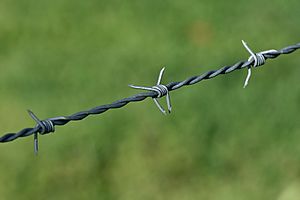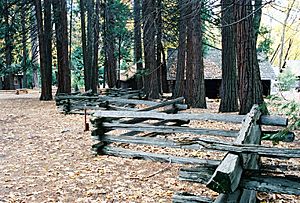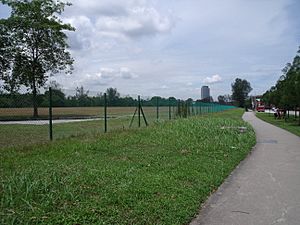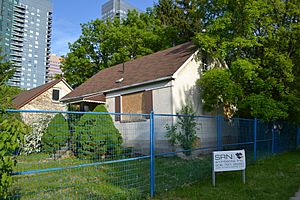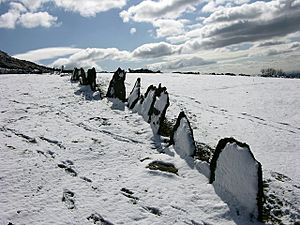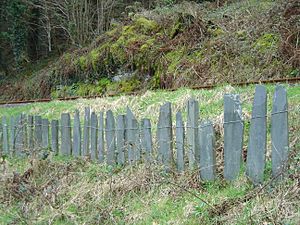Fence facts for kids
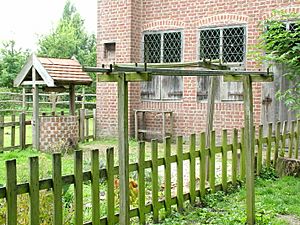
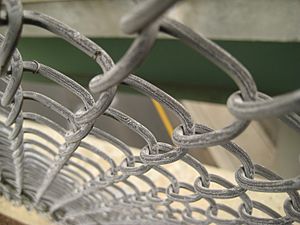
This is about a fence. You may be looking for the sport of fencing.
A fence is something built like a low wall, often made of metal or wood, to keep something in or to keep something out. They are always outside. Fences can be painted many colors.
Types
By function
- Agricultural fencing, to keep livestock in and/or predators out
- Acoustic fencing, to reduce noise pollution
- Privacy fencing, to provide privacy and security
- Temporary fencing, to provide safety, security, and to direct movement; wherever temporary access control is required, especially on building and construction sites
- Perimeter fencing, to prevent trespassing or theft and/or to keep children and pets from wandering away.
- Decorative fencing, to enhance the appearance of a property, garden or other landscaping
- Boundary fencing, to demarcate a piece of real property
- Newt fencing, amphibian fencing, drift fencing or turtle fence, a low fence of plastic sheeting or similar materials to restrict movement of amphibians or reptiles.
- Pest-exclusion fence
- Pet fence Underground fence for pet containment
- Pool fence
- Snow fence
A balustrade or railing is a kind of fence to prevent people from falling over the edge, for example, on a balcony, stairway (see railing system), roof, bridge, or elsewhere near a body of water, places where people stand or walk and the terrain is dangerously inclined.
By construction
- Brushwood fencing, a fence made using wires on either side of brushwood, to compact the brushwood material together.
- Chain-link fencing, wire fencing made of wires woven together
- Close boarded fencing, Strong and robust fence constructed from mortised posts, arris rails and vertical feather edge boards
- Concrete fence, easy to install and highly durable
- Ha-ha (or sunken fence)
- Hurdle fencing, made from moveable sections
- Murno Gladst Fence, a thick, sturdy wall driven deeply into the ground to deter burrowing, often supporting higher ground level inside.
- Palisade (Stakewall)
- Picket fences, generally a waist-high, painted, partially decorative fence
- Post-and-rail fencing
- Roundpole fences, similar to post-and-rail fencing but more closely spaced rails, typical of Scandinavia and other areas rich in raw timber.
- Slate fence, a type of palisade made of vertical slabs of slate wired together. Commonly used in parts of Wales.
- Spear-top fence
- Split-rail fences made of timber, often laid in a zig-zag pattern, particularly in newly settled parts of the United States and Canada
- Stockade fence, a waist-high or higher solid fence composed of contiguous or very closely spaced round logs, posts, stakes, or half-round boards pointed at the top. This type of fence is commonly used for privacy.
- Vaccary fence, (named from Latin vaca - cow) a fence to restrain cattle. Made of upright thin slabs of stone, the slabs are not necessarily linked to each other. Found in various places in the north of the UK where suitable stone can be found.
- Vinyl fencing
- Wattle fencing, of split branches woven between stakes.
- Wood-panel fencing
- Wrought iron fencing, made from tube steel, also known as ornamental iron.
- Hedge, including:
- Cactus fence
- Hedgerows of intertwined, living shrubs (constructed by hedge laying)
- Live fencing is the use of live woody species for fences.
- Turf mounds in semiarid grasslands such as the western United States or Russian steppes`
- Wall fences, including:
- Dry-stone wall or rock fence, often agricultural
- Wire fences
- Smooth wire fence
- Barbed wire fence
- Electric fence
- Woven wire fencing, many designs, from fine chicken wire to heavy mesh "sheep fence" or "ring fence"
- Welded wire mesh fence
Images for kids
-
During the Cold War, West German trains ran through East Germany. This 1977 view shows how East German authorities placed fences near the tracks to keep potential defectors at bay
-
Security fence for schools in Korea
-
Mass concrete fence in Russia
-
A wattle fence at Sanok-Skansen outdoor museum in Poland
See also
 In Spanish: Valla para niños
In Spanish: Valla para niños


